Built on Hope
How the Ghanian metropolis Accra is tackling the double effect of climate change and the increasing numbers of newcomers seeking to make a living in the city.
* This article was originally published by the Bosh Foundation
Text by Jamila Akweley Okertchiri
Pictures by Natalija Gotmalova
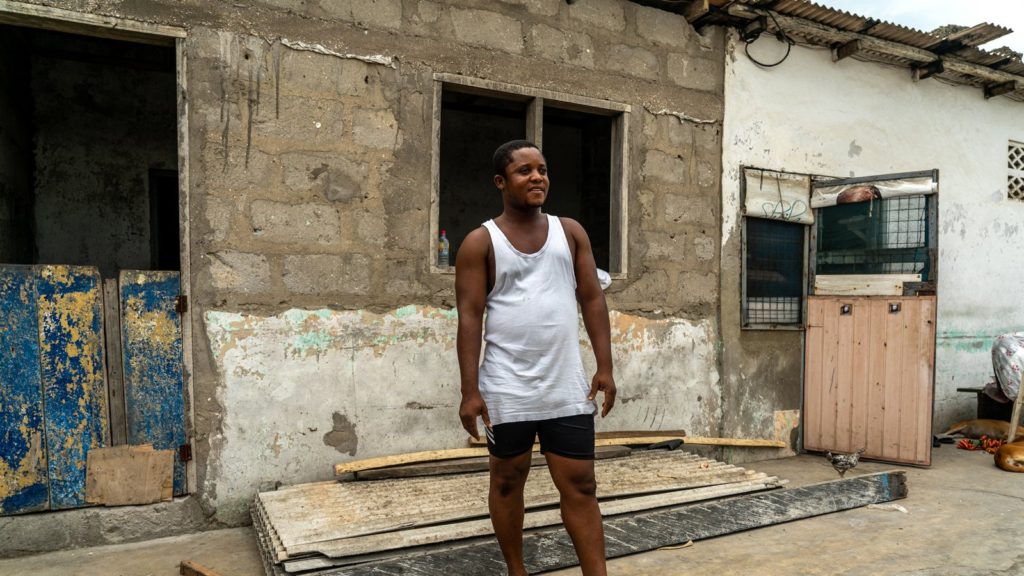
When dark clouds appear over the Gulf of Guinea, Matilda Aduuni is filled with a sense of dread. Not because the 24-year-old is worried about getting wet or how a storm could disrupt her seamstress business. For Matilda, every gathering of clouds could mean destruction. Together with her husband she lives in a makeshift wooden structure in Glefe, a densely populated informal settlement near Accra that is situated between a lagoon and the ocean and is very susceptible to flooding and erosion. After a severe rainstorm in spring, she is busy mopping up the water that has flooded in again. But things could be worse: “The last time it rained the storm ripped off the roof of the room and we had to roof it again.”
Two years ago, Matilda migrated from northeast Ghana to Accra because she had no help to start her own fashion business in her hometown after completing her dressmaking training. Her parents are peasant farmers and could not afford to get her a sewing machine. And she made very little money working in local fashion shops. “I came to Accra to look for a better job,” she says. Matilda dreams of opening her own fashion shop in the future and charging higher prices, but even now she can send some money she earns by sewing to her family every month – “sometimes GHS 100 (12,50 EUR), sometimes GHS 200 (25 EUR)”.
The water gets closer and closer
Matilda and countless others have come to the big city to look for greener pastures and improved food security. But often they end up in low-income, informal neighborhoods like Glefe, which is segregated from the Accra Metropolitan Assembly (AMA) by Lake Bebu. Glefe lacks proper roads, access to water and sanitation, as well as drainage systems. The water in the area is greenish with multi-colored plastic litters. “We have a sea defense wall here but sometimes when it rains heavily, the water gets closer and closer,” Matilda says.

Matilda Aduuni, 24, migrated from the Northern part of Ghana to Glefe informal settlement in Accra in December 2021 due to the lack of employment opportunities where she now runs a dressmaking business.
Informal neighborhoods are a common phenomenon in the capital of Ghana, home to over five million people, according to the Ghana Statistical Service 2021 Census, and host to the seat of government and its agencies, educational institutions, and businesses, as well as several indigenous communities and settlements of people who migrate to Accra. Around one in six of Greater Accra residents are estimated to have been born outside the region.
In recent times, harsh climate conditions have driven more and more people from rural areas to the cities. According to AMA data, about two million people enter Accra each day for various socio-economic reasons – but not all of them leave at the end of the day. Some who decide to stay end up in one of the city’s 11 informal neighborhoods to begin their ‘Accra Life’.
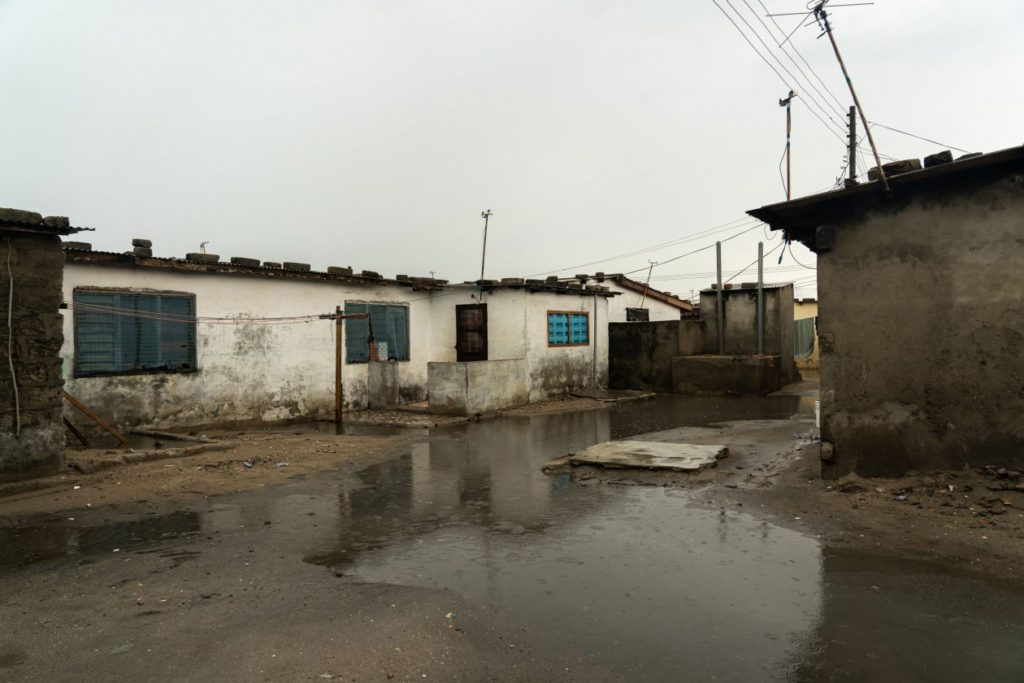
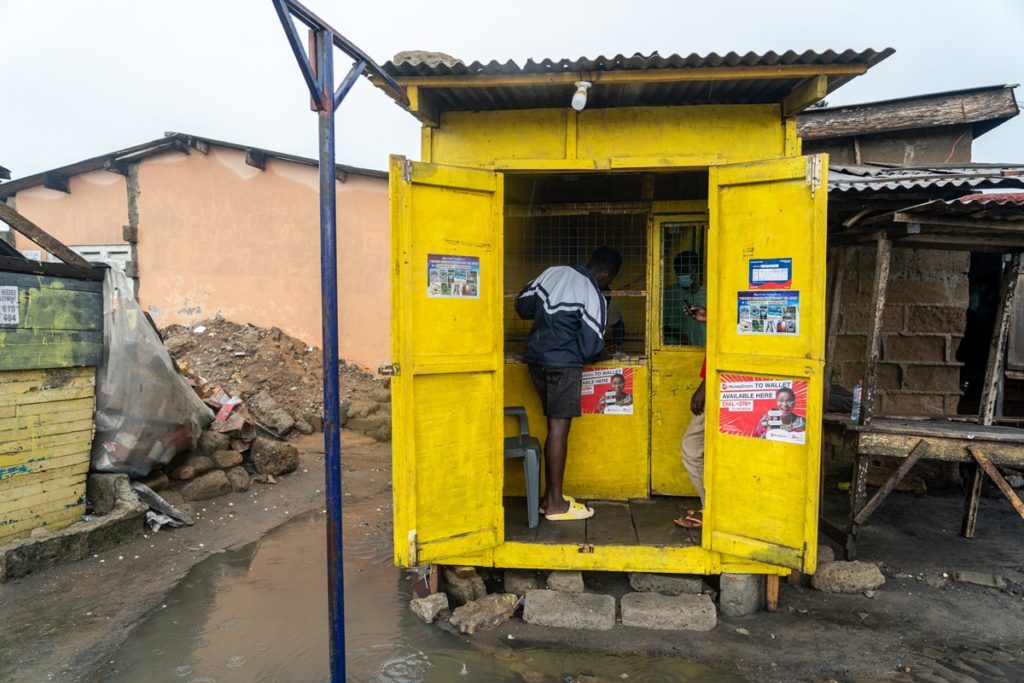
Flooding in Glefe after heavy rainfall.
The biggest informal settlement in Accra is called Old Fadama or Agbogbloshie, spanning over 1.6 hectares of wetlands just beyond city limits and home to some 80,000 Ghanaians, most of whom came from rural communities outside Accra. And each one of them has their own story.
In 2001, Alhassan Baba Fuseini arrived in Old Fadama. He came from the Savelugu Municipal Assembly in the Northern Region of Ghana after completing his High School diploma. “I wanted to stay and support my parents,” he says, but his family could not afford to further his education with their maize farm produce because of inconsistent rainfall patterns and prolonged dry seasons. “My mission was to get a job to enable me to save some money and continue to go to school,” he adds.
According to the recent study “Governing Climate Mobility” by the Center for Migration Studies (CMS), University of Ghana, extreme climate conditions like drought and heavy rains are major push factors for people in northern Ghana to leave for the big cities. “What is interesting is that it is not only northern Ghana – even the places with good vegetation are experiencing climate change,” says Professor Joseph Kofi Teye, Director of CMS, “The rains are coming but not at the right time and this affects production.”
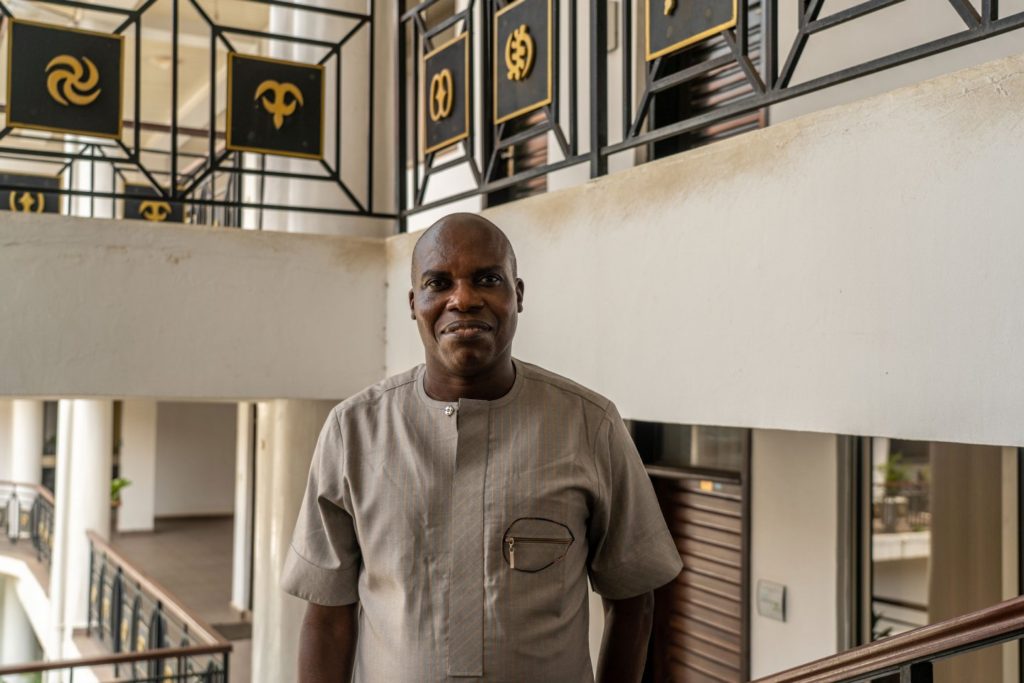
Professor Joseph Kofi Teye, the director of the Centre for Migration Studies of the University of Ghana.
That is why more and more people are having to leave their farms. Research shows that farmers move to the former Brong Ahafo and Eastern regions where rain fall regimes are better, while the young men and women tend to move to the cities, and most often to the informal neighborhoods. As Teye says, “climate change is interacting with other factors like poverty, lack of employment avenues, and social change.”
Alhassan lived in a wooden shack with a relative at Old Fadama until he got a job as a casual worker at factories, which allowed him to earn some money to provide for himself and save towards his education. Today, he is the national coordinator for data collection at the Ghana Federation of the Urban Poor, a local community chapter of Peoples Dialogue, an affiliate of Slum Dwellers International (SDI) in Ghana that aims to foster the integration of underprivileged communities into city life. Together with the Zolberg Institute on Migration and Mobility, SDI tries to identify solutions from the perspective of local communities to address the needs of environmental migrants and their host communities at the neighborhood and city levels. This project, run in Accra, Freetown, Dar es Salaam and Monrovia, is supported by the Robert Bosch Stiftung.
In a way, it’s the perfect job for Alhassan: from his own experiences he knows first-hand what challenges slum dwellers are facing; but he is also a great example of how some migrants can achieve great things in their new home.
“Poor people have to pay for everything“
He remembers a challenging life: “There is no building plan and everyone puts up their wooden or aluminum shacks where there is space.” Those who have a little money build with cement blocks. But there are no standardized infrastructure facilities in the homes. “So, we have to pay any time we want to use the public toilet. We also buy water from the tankers for our daily activities; we have to pay for everything.”
For a long time, slum dwellers were not considered for development programs like the provision of improved sanitation facilities by the city authorities. Because they don’t have a tax number or an official address, they are living in a parallel system – a tale of two cities. As Alhassan says, “they tend to focus their policies on the people in the formal settlements (housing), but we migrants are also here working to first make a living and also add to the development of the city.”
That’s even more important because climate change is not only increasing migration from rural areas to the city but also having a negative impact on vulnerable slum dwellers.
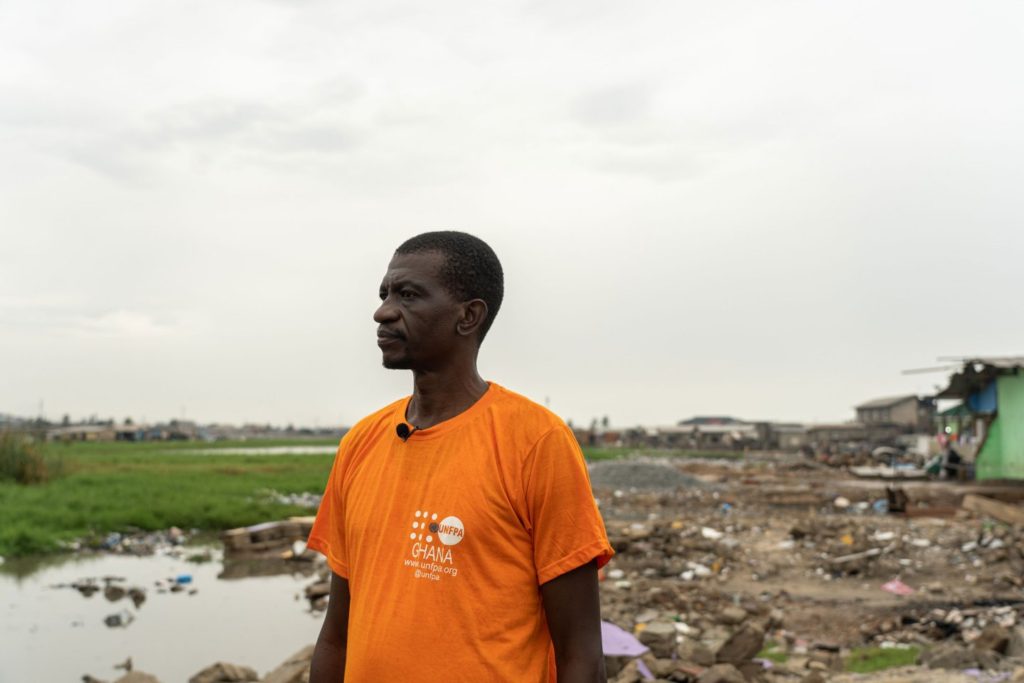
Alhassan Baba Fuseini, a representative of Slum Dwellers International in Glefe community, stands on the bank of the heavily polluted Glefe lagoon.
Putting everyone on the map
NGOs like SDI are trying to put slum dwellers on the map. They piloted a project called Hunger Resilience with the Accra Metropolitan Assembly (AMA) and also helped to collect data on flooding which showed the flood-prone settlements in Accra, informal settlements with formal security of tenure, as Salifu Abdul-Mujeeb, Project Manager at SDI-affiliate Peoples Dialogue, points out. He believes it is necessary to include all stakeholders in a city to develop a successful climate change adaptation strategy and make Accra more resilient.
And he feels that his counterparts in the city’s administration are beginning to see it the same way. However, he believes the city should be even more inclusive in its policy development and implementation. “We need to create a direct relationship between the city, civil society, slum dwellers, and informal sector groups, so that we can hear from them and include their views into decisions the city authority takes,” Salifu Abdul-Mujeeb says.
Integration of informal and formal life
Indeed, the City of Accra is taking more robust actions to address the effects of climate change and ensure newcomers to the city and citizens have an improved quality of life. In 2020, the AMA developed a five-year Climate Action Plan (CAP) which identifies a range of actions that are supposed to achieve significant reductions in greenhouse gas emissions, improve the quality of life, create green jobs, and set the city on a path towards climate resilience and carbon neutrality by 2050. The CAP is building on national climate policies and aligns with Ghana’s Sustainable Development Goals.
But even before that, in 2008, the city developed a resilience strategy that identified the stressors – transport, housing, waste management, energy use, cost of living – that hinder its resilience and advanced strategies to help address them. “In the last years, local politics has demonstrated the city consciousness of migrants and the impact of climate change,” says Desmond Appiah, Program Manager for African Cities For Clean Air of the city network, C40 Cities and former advisor to the Mayor of Accra on resilience and sustainability: “The first and most important thing the city did is to recognize that informality is part of our city and people sometimes underestimated it,” he notes.
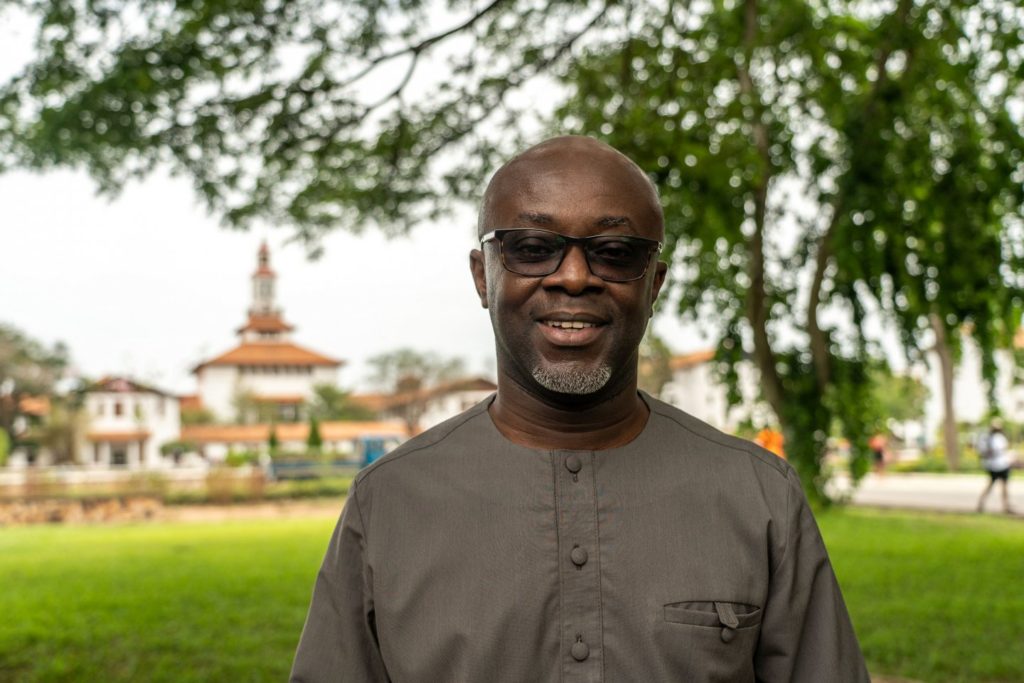
Desmond Appiah, the program manager for C40 African Cities For Clean Air.
The administration veteran reports that policies were previously only addressing the 20 per cent of the people in formal settlements – leaving the 80 per cent who are from the informal sector in the dark. “That is a major reason why a lot of the policies also failed because the city cut off a huge chunk of its society,” he adds.
But this has changed: The city has started involving the informal sector in its decision making, deliberations, and activities. For instance, the informal sector waste collectors were identified as critical players in waste management and therefore linked with formal waste companies. “The city also introduced informal recyclers into formal waste management system to help make them more efficient,” he adds. “The Mayor of Accra also visits informal settlements once a week to interact with them.” These initiatives, he says, have helped the city in the effective implementation of proper waste management and increased support from the informal sector for policies.
For Desmond Appiah, migration is not just needed, but also necessary in helping cities develop. “The city has a plan, and it is to build a smart, resilient, and sustainable city. But we need to engage and ensure all communities are involved in the process. We need to hear the views of the migrants and appreciate their concerns – and integrate them into the planning.”